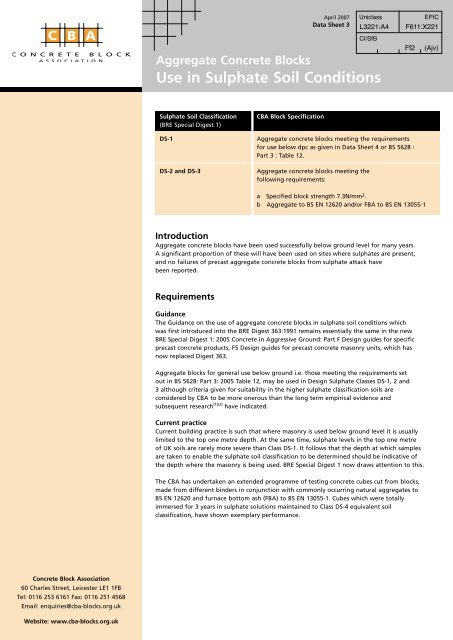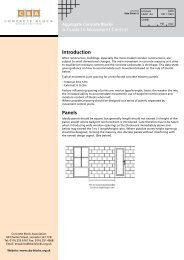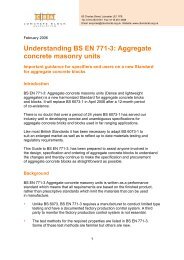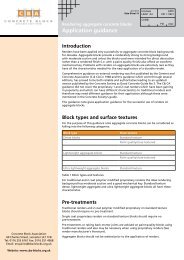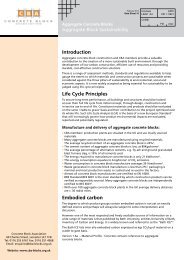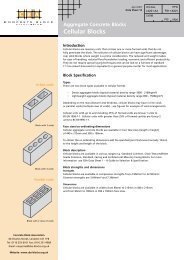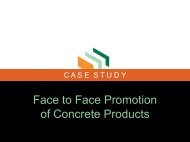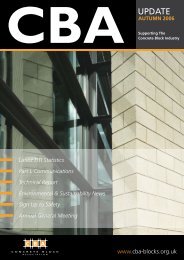Use in Sulphate Soil Conditions - Concrete Block Association
Use in Sulphate Soil Conditions - Concrete Block Association
Use in Sulphate Soil Conditions - Concrete Block Association
You also want an ePaper? Increase the reach of your titles
YUMPU automatically turns print PDFs into web optimized ePapers that Google loves.
April 2007<br />
Data Sheet 3<br />
Uniclass<br />
L3221:A4<br />
EPIC<br />
F611:X221<br />
CI/SfB<br />
Aggregate <strong>Concrete</strong> <strong>Block</strong>s<br />
<strong>Use</strong> <strong>in</strong> <strong>Sulphate</strong> <strong>Soil</strong> <strong>Conditions</strong><br />
Ff2<br />
(Ajv)<br />
<strong>Sulphate</strong> <strong>Soil</strong> Classification<br />
(BRE Special Digest 1)<br />
DS-1<br />
DS-2 and DS-3<br />
CBA <strong>Block</strong> Specification<br />
Aggregate concrete blocks meet<strong>in</strong>g the requirements<br />
for use below dpc as given <strong>in</strong> Data Sheet 4 or BS 5628 :<br />
Part 3 : Table 12.<br />
Aggregate concrete blocks meet<strong>in</strong>g the<br />
follow<strong>in</strong>g requirements:<br />
a Specified block strength 7.3N/mm 2 .<br />
b Aggregate to BS EN 12620 and/or FBA to BS EN 13055-1<br />
Introduction<br />
Aggregate concrete blocks have been used successfully below ground level for many years.<br />
A significant proportion of these will have been used on sites where sulphates are present,<br />
and no failures of precast aggregate concrete blocks from sulphate attack have<br />
been reported.<br />
Requirements<br />
Guidance<br />
The Guidance on the use of aggregate concrete blocks <strong>in</strong> sulphate soil conditions which<br />
was first <strong>in</strong>troduced <strong>in</strong>to the BRE Digest 363:1991 rema<strong>in</strong>s essentially the same <strong>in</strong> the new<br />
BRE Special Digest 1: 2005 <strong>Concrete</strong> <strong>in</strong> Aggressive Ground: Part F Design guides for specific<br />
precast concrete products, F5 Design guides for precast concrete masonry units, which has<br />
now replaced Digest 363.<br />
Aggregate blocks for general use below ground i.e. those meet<strong>in</strong>g the requirements set<br />
out <strong>in</strong> BS 5628: Part 3: 2005 Table 12, may be used <strong>in</strong> Design <strong>Sulphate</strong> Classes DS-1, 2 and<br />
3 although criteria given for suitability <strong>in</strong> the higher sulphate classification soils are<br />
considered by CBA to be more onerous than the long term empirical evidence and<br />
subsequent research (1)(2) have <strong>in</strong>dicated.<br />
Current practice<br />
Current build<strong>in</strong>g practice is such that where masonry is used below ground level it is usually<br />
limited to the top one metre depth. At the same time, sulphate levels <strong>in</strong> the top one metre<br />
of UK soils are rarely more severe than Class DS-1. It follows that the depth at which samples<br />
are taken to enable the sulphate soil classification to be determ<strong>in</strong>ed should be <strong>in</strong>dicative of<br />
the depth where the masonry is be<strong>in</strong>g used. BRE Special Digest 1 now draws attention to this.<br />
The CBA has undertaken an extended programme of test<strong>in</strong>g concrete cubes cut from blocks,<br />
made from different b<strong>in</strong>ders <strong>in</strong> conjunction with commonly occurr<strong>in</strong>g natural aggregates to<br />
BS EN 12620 and furnace bottom ash (FBA) to BS EN 13055-1. Cubes which were totally<br />
immersed for 3 years <strong>in</strong> sulphate solutions ma<strong>in</strong>ta<strong>in</strong>ed to Class DS-4 equivalent soil<br />
classification, have shown exemplary performance.<br />
<strong>Concrete</strong> <strong>Block</strong> <strong>Association</strong><br />
60 Charles Street, Leicester LE1 1FB<br />
Tel: 0116 253 6161 Fax: 0116 251 4568<br />
Email: enquiries@cba-blocks.org.uk<br />
Website: www.cba-blocks.org.uk
Research<br />
The CBA research work supports the BRE statement that surface carbonation enhances<br />
sulphate resistance. Consequently the requirement <strong>in</strong> Digest 363 for aggregate concrete<br />
blocks to have 50% of the least cross-sectional area to be carbonated for sulphate soil<br />
classifications DS-2 and 3 has been replaced by a requirement for blocks to be surface<br />
carbonated for a m<strong>in</strong>imum of 10 days.<br />
Such exposure to air and surface carbonation will normally take place without any special<br />
provisions between the time of manufacture and back-fill<strong>in</strong>g after construction.<br />
CBA research has also shown that by virtue of its particular manufactur<strong>in</strong>g process, block<br />
concrete, despite its high entrapped air content and open texture has aggregate particles<br />
bonded together by a dense cementitious paste. (2)<br />
References:<br />
1 Pettit G J L, Harrison W H and Littleton I, <strong>Sulphate</strong> Resistance of Aggregate <strong>Concrete</strong> <strong>Block</strong>s<br />
BIBM Congress, Paris 1996.<br />
2 Pettit G J L, Harrison W H. Understand<strong>in</strong>g the durability of aggregate concrete masonry units<br />
through a comparison of cement matrices of wet and semi-dry mix concrete. BIBM Congress,<br />
Venice 1999.<br />
To receive other data sheets <strong>in</strong> this series, a list of CBA members or<br />
for further <strong>in</strong>formation please visit our website at www.cba-blocks.org.uk<br />
CBA Technical Helpl<strong>in</strong>e 0116 222 1507<br />
© The <strong>Concrete</strong> <strong>Block</strong> <strong>Association</strong> 2007<br />
Although The <strong>Concrete</strong> <strong>Block</strong> <strong>Association</strong> does its best to ensure that any advice,<br />
recommendation or <strong>in</strong>formation it may give is accurate, no liability or responsibility of any<br />
k<strong>in</strong>d (<strong>in</strong>clud<strong>in</strong>g liability for negligence) is accepted <strong>in</strong> this respect by the <strong>Association</strong>, its<br />
servants or agents.<br />
This datasheet is manufactured from ECF (Elemental Chlor<strong>in</strong>e Free) pulp sourced from<br />
certified or well managed forests and plantations. It is totally recyclable, biodegradable<br />
and acid-free.


